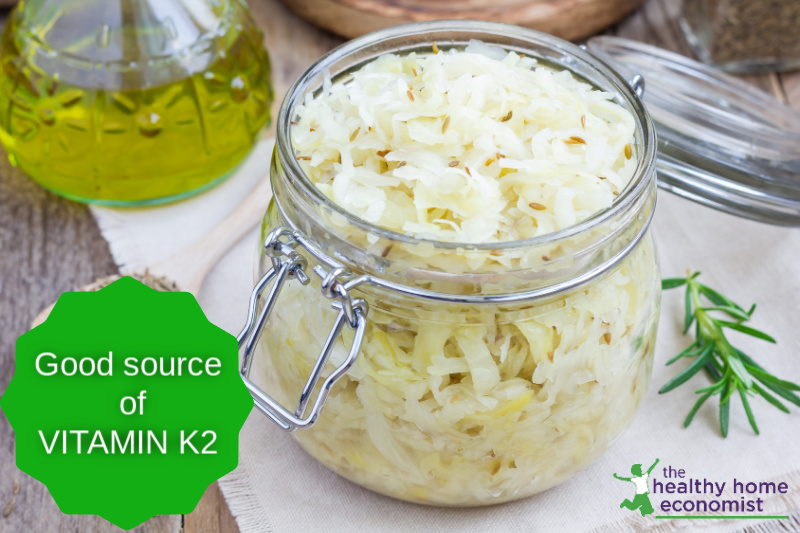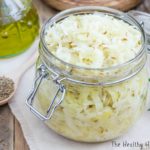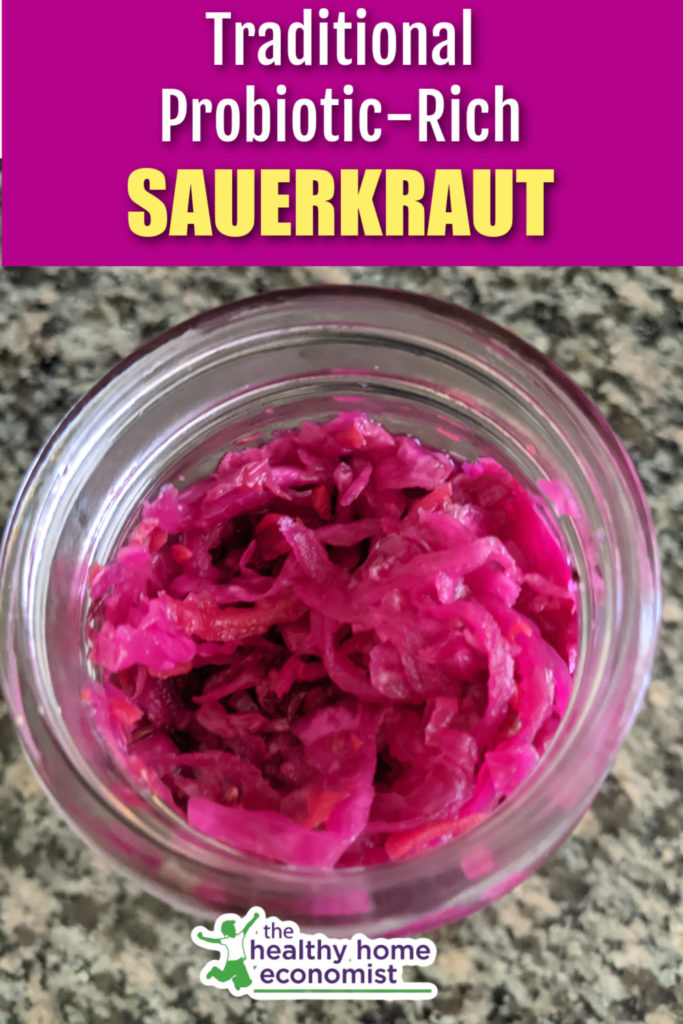Recipe and detailed video instruction on how to make traditional sauerkraut that is loaded with probiotics and Vitamin K2 for better digestion and health. 
By popular demand, the process of making homemade sauerkraut is explained and demonstrated in the two video lessons below. The written recipe is also provided by those who wish to dive right in.
This traditional food is probiotic-rich and very nutrient-dense unlike the vinegar-packed sauerkraut wanna-be’s at the store.
The first video covers a brief history of sauerkraut and what you need on hand to make it. The second video covers how to make sauerkraut yourself quickly and easily in your kitchen.
The sauerkraut recipe I use is based on the Nourishing Traditions method.
Benefits of Fermenting Cabbage
Eat small amounts of this probiotic-rich condiment with cooked foods to improve digestion and assimilation.
Remember that fermenting does not reduce the goitrogens (thyroid suppressing substances) in the cabbage. So, if you have thyroid issues, you may wish to consider avoiding this particular condiment.
If your thyroid status is good and you eat plenty of iodine-rich foods like grassfed butter, then sauerkraut is a healthy addition to the diet.
Loaded with Vitamin K2
Did you know that properly cultured cabbage contains a significant amount of natural Vitamin K2? This is an elusive nutrient that is very hard to get in the diet. It is essential for strong bones and healthy teeth.
The USDA reports that one cup of sauerkraut contains 81 mcg. No doubt this is the commercial, pasteurized stuff that the USDA is testing too.
I would venture to suggest that making raw sauerkraut yourself and fermenting properly would potentially contain larger amounts.
Natural Remedy for Reflux
Another bonus of eating raw fermented cabbage is that it is a natural way to prevent acid reflux. Simply eat a mouthful or two a few minutes before the start of a meal.
Want to experience these benefits for yourself? Two detailed video lessons are included with the recipe below.
Tip: Be sure to wear an apron when you make this dish as you will see in the video! ?
Why don’t you try it today! You will never go back to the pasteurized, shelf stable sauerkraut at the store!

Homemade Sauerkraut Recipe
Basic recipe for homemade sauerkraut as traditionally made as a live cultured food loaded with probiotics and enzymes to aid digestion and absorption of nutrients.
Ingredients
- 1 green or purple cabbage medium size, preferably organic
- 4 Tbl liquid whey
- 1 Tbl caraway seeds
- 1 Tbl sea salt
Instructions
-
Core and chop cabbage. Place all the chopped cabbage and other ingredients together in a large sturdy bowl.
-
Pound the juices out of the cabbage thoroughly with a kitchen pounder of some kind for a full 10 minutes.
-
Tightly pack the cabbage into a one quart mason jar leaving at least 1 inch of space at the top. Tightly seal with the lid.
-
Leave on the counter for 3 days and then refrigerate.
-
The flavor of the homemade sauerkraut improves over time. It will last many months in your refrigerator or cool cellar.
Recipe Video

References
(1) Vitamin K2 in Sauerkraut
(2) Nourishing Traditions
More Fermented Food Recipes
Love this sauerkraut recipe? Try these other delicious fermented foods and drinks below and unleash the power of a traditional diet in your home.
How to Make Fermented Lemonade
How to Make Orangina
Mango Chutney Recipe
Homemade Apricot Butter
Fermented Potatoes
Probiotic Corn Relish
How to Make Fermented Cilantro Salsa
Beet Kvass Recipe








Hi Sarah,
Thank you for all your time and effort to maintain this site and the hard work on the videos!
Five heads of cabbage in my backyard garden just became mature, so I put together a small “test batch” of your saurkraut recipe with half a head.
My kraut sat at room temp from Saturday through Tuesday. I opened the lid and tasted a bite…very salty right now. There was still a lot of green color and I’m not seeing any bubbles. I left it out on top of the fridge for one more day. This morning I put it in the fridge.
Questions:
Should I leave it out at room temp (currently avg 66-68 F) until the leaves yellow?
Now that I’ve popped the top and exposed it to air, should I refrigerate it, even though it is still fairly green?
Should it bubble or not?
I’m looking forward to storing the majority of the crop as saurkraut and want to make sure I’m doing it right.
Thanks much,
Chris
Thank you so much for making this and your other videos. I know that takes a lot of your time! I was wondering how should sauerkraut smell once done fermenting? I’m not sure how tight I put the lid on mine but I can hold the jar close to me and there is a smell. If it’s a stinky smell is that good? If the smell is wrong should I start again?
Hi Sarah,
While I am happy to report that my husband is NAGGING me to make this and I am definitely interested in trying your version with caraway seeds (I make a cabbage butter sidedish that I add Caraway to and I go back for more, maybe this will break my distain of sauerkraut) I wanted to add to the ice cream conversation you have earlier in the post.
My husband and I own a small batch ice creamery where we craft A2 ice cream from guernsey and jersey milks.
Using stevia will most likely NOT work in ice cream making, at least by itself, as sugar acts as anti-freeze. It’s one of the things in the ice cream that keeps it from making an icecicle, instead of a frozen curd.
I do however know that honey is a better anti-freeze than sugar, so you need less of it to produce the same effect. You could try to add some honey, enough for the desired effects, and then stevia to complete the sweet taste. It should result in a lower glycemic ice cream with the added benefits of the honey. But I would not know the exact measurements.
Hope it helps!
Asta
Hi Sarah,
I made Sauerkraut from Nourishing Traditions and left it on the counter to ferment for 3 days before putting it into the fridge. The day I made it, I went out of town and forgot to ask my husband to put the Sauerkraut in the fridge for me after 3 days…when I returned home 9 days later, the kraut was still on the counter! AND it was from the cabbage in our garden!! Is it still good to eat if it fermented on the counter for 9 days instead of 3 days?
Sarah,
Thanks so much for the video. LOVE the pounder you used. I cannot find a wooden one anywhere, and would love to know where you got yours. Thanks!
Hi Sarah,
I’m thinking to make your Sauerkraut recipe pretty soon using the whey that I get from making Milk Kefir. Do you think it will work the same as the yogurt whey or maybe this is not a good idea? Thanks!
Sarah,
You mentioned using it as a condiment. Does that mean you wouldn’t serve it as a side, you would just use a little bit?
jan
Help! I tried making kraut by this NT recipe, using only salt (no whey). I had a huge head of cabbage, and I packed it into 3 jars. (I’m not sure of the exact size of the jars, as I am not able to access “Mason” type jars, but they were close to quart size.) On day 3, it looked quite lovely, and I put it in the ‘frig. (Though, in truth, I have no idea what it was “supposed” to look like!) On day 5, the liquid started disappearing. (It had been level with the cabbage.) By day 7 or 8, two jars started turning purplish-brown on top. They also smelled strange. I didn’t know what to do, so I left it a few days. On about day 10, I scraped off the ugly colored cabbage and put what remained in the ‘frig. So, what did I do wrong?! And are my two jars safe to use, if the cabbage doesn’t turn purple??
This is the second batch of sauerkraut that I have made. The first, by a different recipe, was a disaster. And now the second looks like it’s headed to the trash also. I’m getting very discouraged (especially since I keep hearing how “easy” this is!), and my hubby is frustrated because I keep throwing money in the trash! Any advice is appreciated!
As a side note, the kraut is VERY salty. By any chance, does the salt flavor get masked as it ferments further? I tried the “good” jar, and I could hardly choke it down. I’m new to traditional diets, and I’ve really been hoping to get started in fermented foods. If I don’t have access to a whey starter, can I use commercial yogurt and strain it? (I think I read about that somewhere.) Thanks for your help, and sorry for the novel!
Just wanted to leave comment – I just made a whole bucket of sauerkraut. I put mine in the freezer to store and like it much better than refrigerated. When you freeze it it is softer, more like canned. I don’t like crunchy sauerkraut 😉 I may just be weird that way. I also make sure mine is very fermented before freezing it.
I just processed some that I left (due to life happening and not being able to package it) for 3 months in a bucket and it was just really good. It was in a cool location (60’s probably) so it didn’t ferment very quickly.
I’m still trying to find tasty ways of using it. I added some to pork chops the other day – yum!
Where do you find a pounder like the one you used in your video? All I can find is morter and pestle sized. I used a meat tenderizer for my current batch, but I think one like you had would be a lot easier to use.